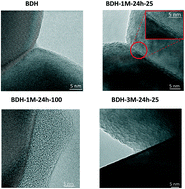Alkaline treatment as a means to boost the activity of TiO2 in selective photocatalytic processes†
Abstract
In this work, the activity enhancement of TiO2 photocatalysts by alkaline treatment has been investigated. Commercial (BDH, U.K., anatase phase) TiO2 samples, treated in alkaline solutions of NaOH at different concentrations and temperatures, were tested for the photocatalytic partial oxidation of 3-pyridinemethanol in water under UVA irradiation to form vitamin B3. Photocatalyst characterization has been carried out by XRD, BET, TEM, TGA, photoluminescence, FTIR, Raman, DRS, EPR and photocurrent measurements. The alkaline-treated samples showed an increased activity of up to 7 times (by considering first order rate constant values) compared to untreated BDH and the superior performance was maintained even after a thermal treatment at 400 °C, while the selectivity values were affected only marginally by the treatment (being ca. 40% and 15% for 3-pyridinemethanal and vitamin B3, respectively). The effect of NaOH concentration and treatment duration on the photocatalytic activity has also been studied extensively. The alkaline treatment has also proven to be effective in modifying the surface properties of another commercial catalyst, i.e., Merck, anatase, improving its reactivity in the conversions of both 4-methoxybenzyl alcohol and 3-pyridinemethanol. The NaOH treatment boosted the porosity and surface area, while lowering the percent crystallinity of the catalysts, due to a higher density of surface hydroxyl groups. It also enhanced the adsorption capability towards the reacting substrate, as shown by FTIR analysis. Despite the oxygen vacancies (or total abundance of Ti3+ centres) not being changed after the NaOH treatment, the process of hole trapping under irradiation is drastically affected due to the different water adsorption capabilities of the samples, as highlighted by EPR. The proposed simple treatment of commercial photocatalysts has the potential to support the development of effective photocatalysts, which do not require complex surface modification or doping to achieve high yields in reactions relevant to the chemical industry.



 Please wait while we load your content...
Please wait while we load your content...